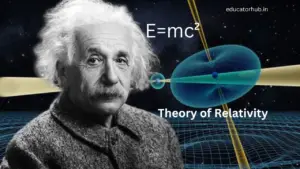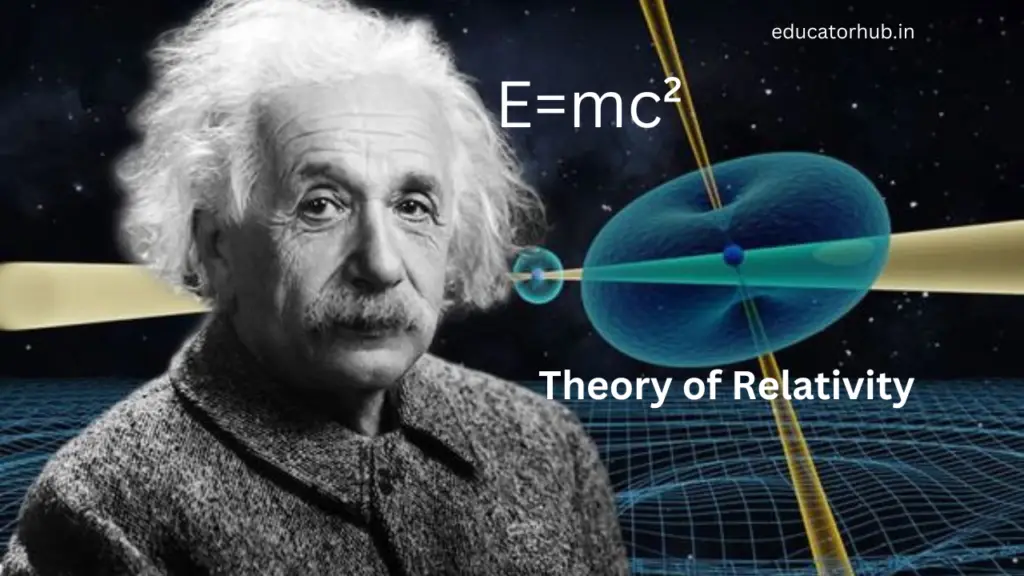
An acclaimed scientific concept that has captured interest is the theory of relativity – a groundbreaking idea introduced by Albert Einstein in the early 1900s that revolutionised our understanding of space-time and gravity dynamics in the universe’s vast expanse. In terms of relativity serves as a framework to grasp the workings of celestial phenomena spanning from planets and stars to enigmatic entities, like black holes. The theory encompasses two principles; the Special Theory of Relativity and the General Theory of Relativity. Let us look at both parts in a common language. In this article read Einstein’s Theory of Relativity Explained.
Part 1 : Special Theory of Relativity
By 1905, the Theory of Relativity Special was published. It is referred to as “special” in the way that it handles particles moving with uniform speed along a straight line. Those are neither connected to acceleration nor gravity; those will be discussed later in the General Theory. Here are the main points:
1. The Speed of Light Is Constant
In Special Relativity theory core principle lies in the idea that the speed of light remains consistent for every observer regardless of their velocity, through the space-time continuum at 300000 kilometres per second (or 186000 miles per second). This universal constant holds no matter if you are standing still in one place during a stroll through the park—or even hurtling through space at half the speed of light—light will always zoom past you at that unwavering speed of 300000 kilometres, per second.
This concept came as quite a shock because in our lives we anticipate speeds to combine together seamlessly. For example, when one vehicle is moving at 70 km/h and another car is closing in from behind at 50 km/h you would expect the first car to appear to be moving at 20 km/h relative to the second car. However, with light, it’s a story. Regardless of the circumstances light consistently travels at a constant speed.
2. Time Dilation (Time Slows Down at High Speeds)
The theory of Special Relativity by Albert Einstein makes us understand that time is not uniform at everywhere. It can change depending on your velocity. We call it time dilation. If you are travelling very close to the speed of light, time will pass slower for you than for a person at rest.
Consider two twins Alice and Bob. Alice remains on Earth while Bob goes on a spaceship almost as fast as light speed. When Bob returns, he will be younger than Alice because he spent less time on his journey in comparison with her. This is the so-called “Twin Paradox”.
Read further Einstein’s Theory of Relativity Explained…
3. Length Contraction (Distances Shrink at High Speeds)
Just as time can slow down, so too can distances become shorter when moving at very high speeds. This phenomenon is called length contraction. When you travel close to the speed of light, other objects will appear to shrink along the direction of your motion.
Take for instance the spaceship of Bob if it moves at very high speeds, Earth will appear to be closer to him than it really is. Nevertheless, for someone on Earth, the distance is still the same. Length contraction takes place only from the point of view of a person moving at high speeds.
4. Mass Increases with Speed
Objects gain more mass as they increase their speed. For instance, at speeds close to the speed of light, the mass increases enormously. Therefore, nothing that has mass can reach the speed of light. Approaches to that speed require greater amounts of energy for increased velocity than are currently available, and at nearly the speed of light would require an infinite amount of energy to continue accelerating, which is impossible.
5. E=mc² (Energy and Mass Are Related)
E=mc² is one of the most famous equations from Special Relativity. This implies that energy (E) equals mass (m) times the speed of light (c) squared. Simply put, this equation conveys that matter can be transformed into energy and vice versa. AI-powered systems are driven by this principle as they use a small amount of energy in order to produce an enormous amount of measurable output.
Also Read : How to Make Money Online
Read further Einstein’s Theory of Relativity Explained…
Part 2 : General Theory of Relativity
In 1915 Einstein carried out the publication of the General Theory of Relativity. This theory is built on Special Relativity telling us about gravitational interaction. General Relativity is a gravity theory, but it dresses quite in another manner than Newton’s one. Instead of considering gravity as a force, Einstein considers it as a curvature or bending of space and time.
1. Space and Time Are Connected
In General Relativity, space and time are not separate. Instead, they are woven together into a “fabric” which is known as spacetime. We live in a 3D universe, but Einstein’s theory introduces time as a fourth dimension. Thus, spacetime is their 4D stage upon which all matters go about.
2. Mass and Energy Bend Spacetime
In General Relativity, gravity is not a force between two objects. Instead, it describes how the mass of planets, stars, and black holes goes to curve the spacetime around them. This curvature of spacetime prompts objects to move towards each other, which we perceive as gravity.
Think of spacetime as a rubber sheet. A heavy ball placed in the centre creates a dip or curve in that sheet. If you roll another smaller ball close to this dip, it will move toward the heavier ball due to the curvature of the sheet. This is similar to gravity. The Sun curves the spacetime around it and this curving makes planets revolve around the Sun.
3. Gravitational Time Dilation
In the framework of General Relativity, time is also influenced by gravity. The stronger the gravitational field, the slower time moves. This is called gravitational time dilation. For instance, a clock on Earth will be behind one in space just a little bit because Earth’s gravity is greater. This effect is negligible for us, however, it plays a crucial role near massive objects such as black holes.
The point comes out very clearly in the action of the GPS satellites which are up there and so experience weaker gravity hence they have to adjust their clocks. If these corrections were not made, then the GPS would be inaccurate.
4. Light Bends Due to Gravity
Besides, as gravity does so spacetime also has an influence on the trajectory of light. Called gravitational lensing is this phenomenon. When light passes close to a large object such as a galaxy or black hole its path is curved. This has been noticed in space where the light from distant stars and galaxies bends around huge objects. It helps scientists study the galaxies which are very far from us.
5. Black Holes (Extreme Curvature of Spacetime)
Black holes are space regions where gravity is extremely strong that even light cannot escape. They occur when huge stars collapse due to their gravity. General Relativity states that a black hole is where spacetime curves infinitely, which is described by the term singularity.
The edge of a black hole where nothing can escape from, is referred to as the event horizon. If you go past the event horizon you can never return. Black holes are akin to cosmic traps and they are capable of so much spacetime warping that it affects the paths of the nearby stars and light.
Key Concepts and Implications of Relativity
Many implications of relativity may surprise us in our efforts to comprehend the universe. Below there are some of them:
1. The Universe Has No Absolute Time
The theory of relativity states that there is no single time that all people experience- the so-called “absolute” time. As per relativity, what counts is where you are and how fast you are moving. This indicates that it is possible for two individuals to experience time differently especially if they move at different speeds or if they occupy different gravitational fields.
2. The Big Bang and Expanding Universe
General Relativity predicts an expanding universe, which then led to the conception of the Big Bang. The universe began from an extremely hot and dense point and has been expanding ever since. It also means that spacetime is by nature stretching, carrying galaxies along with it.
3. Wormholes and Time Travel
Relativity allows them the theoretical possibility of wormholes, which are tunnels through spacetime. A wormhole could connect two points in space so easily that it would allow travel faster than light. Wormholes would also make time travel possible. Theoretically entirely, science doesn’t yet know if they could exist in reality.
Also Read : Who is Lawrence Bishnoi Complete Information in Brief
Read further Einstein’s Theory of Relativity Explained…
Everyday Applications of Relativity
While relativity may sound vague and abstract, it is applied in everyday life.
1. GPS Technology
As mentioned earlier, GPS satellites rely on relativity. They are far enough from the Earth’s surface to experience a weaker gravitational field, so time passes slightly faster for them than it does for clocks on Earth. Engineers have to correct for that difference using both Special and General Relativity to make GPS accurate.
2. Nuclear Power and Weapons
The equation E=mc² represents the foundation of nuclear power. The rest mass gets converted to energy in the nuclear reactions per Einstein’s theory. This process is what fuels the sun and nuclear reactors on Earth. It’s also the principle that operates atomic bombs.
3. Particle Accelerators
In particle accelerators, scientists accelerate particles to study their properties. As the particles approach the speed of light, their mass increases, and time dilation becomes significant. Engineers use relativity to calculate how much energy is needed to reach specific speeds.
Conclusion: (A New Understanding of the Universe)
The theory of relativity changed our concepts about space, time, and gravity. Before Einstein, scientists believed that space and time were constants indepedent from each other. However, they are at present interconnected and fluidic concepts; thus, it creates a fabric that can be stretched, curved as well as ripped.
Relativity has been tested countless times, and the results support what Einstein proposed. From light bending to time variations within GPS satellites, relativity affects much of what we observe and utilise. It’s one of the foundations of modern physics and continues to encourage scientists to investigate the mysteries of the universe.
Although difficult to comprehend, relativity sheds light on the immense and bizarre reality of the universe: time and space are more than what we consider when rolling our eyes at simplicity. Ultimately, Einstein’s theories have led to a whole new array of questions and deeper mysteries that may take humanity several more years to unravel.
Thanks for visit and read Einstein’s Theory of Relativity Explained….
Also Read :
- Best Science Essay In English for Students : 2000+ words
- Meaning of Leisure : Full Details
- Right and Duties of Citizens
- Unlock the Noun Mastery- Explore Hidden Types and Examples
- Most Searched Topics on Google Till Now
To Wikipedia : Click Here
Einstein’s Theory of Relativity Explained



